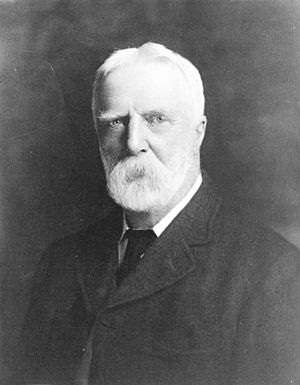Henry John Cambie facts for kids
Quick facts for kids
Henry John Cambie
|
|
|---|---|

Henry John Cambie
|
|
| Born | October 25, 1836 |
| Died | April 23, 1928 (aged 91) Vancouver, British Columbia, Canada
|
| Occupation | Surveyor, Civil Engineer, Pioneer |
Henry John Cambie (born October 25, 1836, in County Tipperary, Ireland – died April 23, 1928, in Vancouver, British Columbia, Canada) was an important Canadian surveyor and civil engineer. He played a big part in building Canada's transcontinental railway, a huge train line that crossed the country. He was also one of the first important people to live in Vancouver.
Contents
Life and Work
Cambie grew up and went to school in England. As a young man, he moved to the Province of Canada (which is now part of Canada). There, he learned how to be a surveyor, someone who measures land.
In 1852, he started working for the Grand Trunk Railway. Seven years later, he joined the Canadian Pacific Railway (CPR). After Canada became a country in 1867, the CPR was hired to build a railway that would stretch across the entire country. This railway would connect the new country and its nearby areas.
Building the Railway in British Columbia
As the railway expanded into British Columbia, Cambie became the main surveyor for the CPR in that province. He believed the best route for the railway was through the Fraser Canyon. He thought it should end at a small logging town called Granville, located on Burrard Inlet.
Cambie was very sure about this route. He had traveled down the canyon to Granville in 1874. He was convinced it was better than other options like Howe Sound or Bute Inlet.
Cambie's Important Role
Cambie's ideas were chosen. In 1876, he became the chief surveyor for the CPR's Pacific Division. He held this important job for four years. After that, he was promoted to chief engineer.
Once his work on the railway was finished, Cambie decided to settle down. In 1887, he moved to Vancouver. This city had been created the year before, taking over from the town of Granville.
Settling in Vancouver
Cambie remembered buying land in Vancouver in 1887. He bought two lots at the corner of Georgia and Thurlow streets. At first, the city wouldn't clear a path for him to reach his property. He had to wait until the end of that year.
He started building his home in 1888. He even had to pay for the first sidewalk on Georgia Street himself because the city wouldn't do it. When he got a telephone, the company kept asking him to pay for the poles. They said no one else would ever live west of Granville Street for a long time.
Today, the area Cambie talked about is in the middle of downtown Vancouver. It is one of the busiest neighborhoods in Canada. The place where Cambie's home once stood is now the site of Vancouver's tallest building, the Living Shangri-La.
Community Contributions
Cambie was a well-known person in the new city of Vancouver. He strongly supported building new things like roads and water systems. He also helped build Christ Church Cathedral. This is a major Anglican church in Downtown Vancouver. He was a key leader there for over forty years. You can find a special plaque inside the church that remembers him.
Cambie's connections with the CPR, especially with its president William Van Horne, were very helpful. The company owned much of the land around Vancouver. Cambie continued to work for the CPR until he retired in 1921.
Death
Henry John Cambie passed away in Vancouver in 1928. He was 91 years old.
Legacy and Namesakes
Many places are named after Henry John Cambie, honoring his contributions.
Roads and Bridges
- Cambie Street - a major road in Vancouver.
- the Cambie Street Bridge
- Cambie Road - a main east-west road in Richmond, British Columbia.
Train Stations
- Northeast of Sicamous, British Columbia (CPR station).
- Southwest of Glacier, British Columbia (CPR station, closed 1916).
- North Richmond on British Columbia Electric Railway (closed 1958).
- A proposed name for Aberdeen station (TransLink) in Richmond, but it was not used.
Other Places
- Henry James Cambie Secondary School in Richmond.

